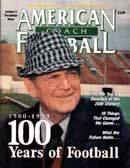Article CategoriesAFM Magazine
|
100 Years of Football Developmentby: Mark Newell© More from this issue 1900-1909 College football had been in existence for 31 years, but in the early days the game resembled something more like soccer. Not until Stanford's Walter Camp started tinkering with the rules in the late 1800's did the game we now know as football take shape. In 1900, prior rules changes had called for an eleven-man scrimmage system, and the "flying wedge" - invented by a Harvard chess expert - was outlawed. In 1906, St. Louis University became the first team to score on the newly legalized forward pass. Cornell University's Glenn S. "Pop" Warner invented the single wing in 1906. Most popular plays included Warner's "hidden ball trick," first used in 1903, and Amos Alonzo Stagg's "Statue of Liberty" play designed for his University of Chicago team in 1908. Most of the rule changes that gave rise to this new style of pla....The full article can only be seen by subscribers.
|
|
|||||||
| HOME |
MAGAZINE |
SUBSCRIBE | ONLINE COLUMNISTS | COACHING VIDEOS |
Copyright 2026, AmericanFootballMonthly.com
All Rights Reserved





